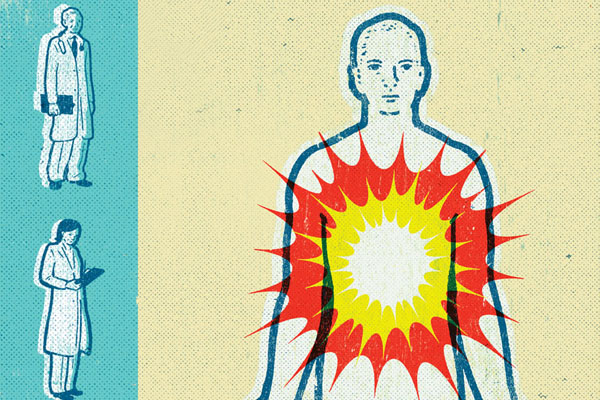Pow! Unleashing immunotherapies & protecting patients
May 31, 2017 | Leigh MacMillan

Illustration by Dan Page
The television ad opens on a city skyline at sunrise, with people looking up curiously at the buildings. “It’s not every day something this big comes along,” says the narrator, as words appear projected on the side of a building. “A chance to live longer,” the words spell out in big, bright capital letters.
The ad is for Opdivo (nivolumab), one of a growing number of immunotherapy drugs that harness the power of the immune system to treat cancer. The drugs have had some stunning successes, achieving durable remissions in some patients with melanoma, lung cancer and numerous other cancers. But the hopeful message in the ad is quickly tempered with a litany of side effects that “may become serious and lead to death,” the narrator says.

Javid Moslehi, M.D., (top) and Douglas Johnson, M.D., MSCI (bottom) have conducted research on immunotherapy side effects.
Although the risk of serious complications for patients taking immunotherapies is low, “even one death is too many,” says Javid Moslehi, M.D., assistant professor of Medicine and director of the Cardio-Oncology Program at Vanderbilt-Ingram Cancer Center. “We are working hard with our oncology colleagues to find ways to give these drugs more safely.”
Vanderbilt investigators are leading efforts to better understand which patients will benefit from immunotherapy drugs and how the drugs cause toxicities. They are carefully monitoring patients during and after therapy, creating databases of patient information, and collecting blood and tissue samples to search for biomarkers of response and toxicity. Such efforts are critical as immunotherapy treatments rapidly expand and more physicians encounter rare side effects that require special management.
“These drugs have now shown activity in cancers that arise in over 10 different organ systems, so they’re going to be used in many more patients going forward,” says Douglas Johnson, M.D., MSCI, assistant professor of Medicine and clinical director of the Melanoma Program. “That means we will see more of the side effects, and we would really like to prevent them if we can.”
Unleashing the immune system
The idea of using the immune system to fight cancer goes back more than a hundred years. “Coley’s toxins,” a mixture of killed bacteria first developed by the surgical oncologist William Coley, were used to treat various types of cancer—with mixed results—starting in 1893.
In more recent decades, attempts to activate an immune response with cancer vaccines or signaling molecules like interleukin-2 have not had a strong clinical impact beyond melanoma and kidney cancer.
But in the beginning of this century, some new drugs that transcend multiple tumor types came along: the checkpoint inhibitors.
“Checkpoints” are molecular mechanisms that work like brakes to slow and keep control of the immune response. They are important in helping prevent autoimmunity (when the immune system attacks normal “self” tissues).
Cancer cells can hijack the checkpoint mechanisms and put the brakes on an anti-cancer immune response, allowing the cancer cells to grow and divide. Checkpoint inhibitors—drugs including nivolumab—release the brakes on the immune system and unleash a cancer-killing response.
Johnson started his fellowship in Hematology-Oncology at Vanderbilt in 2011, the same year that the first checkpoint inhibitor, ipilimumab (Yervoy), was approved to treat melanoma. Other checkpoint inhibitors—nivolumab and pembrolizumab (Keytruda)—were in clinical trials at the time.
“I remember seeing patients during my fellowship who had been treated for melanoma in the first trials in the mid-2000s and were still alive more than five years later at that point,” Johnson recalls. “The historical survival for metastatic melanoma had been about six to nine months on average, and we were seeing these amazing responses, with tumors melting away and patients living for years after their original treatment.”
Some of those patients remain in remission today. “Traditionally, they would not have had that chance,” Johnson says.
Five checkpoint inhibitors are now on the market. Ipilimumab targets a checkpoint called CTLA4; nivolumab and pembrolizumab target PD1; and atezolizumab and avelumab target PDL1. They are being used to treat multiple types of cancer, including melanoma, lung cancer, kidney cancer, bladder cancer, head and neck cancer and Hodgkin’s lymphoma.
Unleashing the immune system against cancer, however, comes with risk. The activated immune system can also attack and cause inflammation of a patient’s healthy tissues.
In general, Johnson says, the anti-PD1/PDL1 drugs are well-tolerated when they are used alone.
“You see headlines about former President Jimmy Carter receiving these drugs and still building Habitat for Humanity houses at age 92,” Johnson says.
But the drugs don’t work for every patient. For melanoma, response rates are about 45 percent for the anti-PD1/PDL1 drugs used alone and about 20 percent for ipilimumab used alone.
Combining an anti-PD1/PDL1 drug with ipilimumab—the two classes of drugs activate the immune system in different, non-overlapping ways—increases the response rate for melanoma to almost 60 percent. But with the combination, side effects are worse.
“There’s a wide range of toxicities and a wide spectrum of severity,” Johnson says. For his patients, the most common side effect is colitis (inflammation of the colon). He also sees pneumonitis (inflammation of the lungs), skin rash, endocrine gland malfunction, liver inflammation and, more rarely, inflammation of the heart and nervous system.
“Almost any organ can be affected by inflammation,” Johnson says.
One patient’s story
In January 2015, Roger Buddy Andrew Boane—he goes by Buddy—noticed a small spot on his right heel. The retired police officer, now 61, who had taught martial arts, served as a personal trainer and run marathons, thought the spot seemed like a “runner’s sore,” he recalls.
The spot grew and bled, and “by February I had started limping,” Boane says.

Buddy Boane, who is being treated with a new immunotherapy, T-VEC, a cancer-killing virus, plans to bike across Tennessee to raise melanoma awareness. Photo by Daniel Dubois.
Boane’s family doctor in Columbia, Tennessee, prescribed antibiotics, but after two rounds of treatment had no effect, he suggested that Boane consult a specialist.
“The specialist took one look at it and said, ‘you’ve got cancer.’ I fell apart; you just don’t expect it,” he says.
A biopsy confirmed that the spot was melanoma, and that it appeared to be confined to the heel. In June, a surgeon in Columbia removed the tumor and about a third of Boane’s heel, which he covered with a flap from Boane’s hip, as well as lymph nodes from the groin.
“The surgeon said if we had waited another month or two, he would be telling me how many months I had left to live, because this was an aggressive melanoma. People don’t realize how dangerous melanoma is,” Boane says.
During Boane’s recovery, however, new spots appeared on his foot near the site of the tumor removal, and he was referred to Johnson.
Following additional testing, Johnson explained multiple treatment options to Boane, who felt that a combination of immunotherapy drugs was the best choice.
“It seemed like the option that had the best chance of getting this stuff out of my body all at once,” Boane says.
He had his first infusion of ipilimumab and nivolumab in November—the drugs are infused every three weeks—and after the second infusion, the spots appeared to be shrinking. Other than some fatigue, Boane says he was feeling fine.
But after two more infusions, Boane ended up in critical condition in the intensive care unit.
He had been treated at a Columbia hospital for a fever and urinary tract infection, but continued to fare poorly after returning home.
“My wife Tina came home from work and said I was as red as I could be,” Boane recalls. “She took my temperature and said, ‘we’re going to Vanderbilt.’ She sped all the way there.”
His blood work revealed concerning numbers for liver function, kidney function and blood sugar, Boane says. Multiple days of treatment in the intensive care unit stabilized Boane’s condition, and Johnson advised that he stop the immunotherapy.
Further testing revealed that Boane had suffered from inflammation of the pituitary gland (hypophysitis), an uncommon reaction that can cause many different symptoms, including diabetes.
A PET scan several months later did not detect any cancer.
“We were tickled to death that the immune therapy had worked,” Boane says.
His remission did not last. A spot appeared on his right knee in August 2016, which was confirmed to be melanoma and was surgically removed in September.
In January of this year, additional spots on his leg were confirmed to be melanoma.
“We’re in the fight for the fourth time,” Boane says.
He is currently being treated with a cancer-killing virus, T-VEC, which is injected directly into each melanoma lesion. The virus infects and kills cancer cells—”exploding” them in the process—and it produces a factor that stimulates an immune response.
Boane remains upbeat and says he will ride a bike across the state of Tennessee—from Kingsport to Memphis—in May to raise melanoma awareness.
“My message to everybody is number one, you’ve got to have faith; number two, you’ve got to have a ‘glad group,’ people around you to help you stay upbeat—I couldn’t have made it through this without Tina and my family and friends; and number three, never give up.”
Understanding the toxicities
Why did Buddy Boane experience inflammation of the pituitary gland while other patients have inflammation of the colon or lungs or heart or endocrine glands?
“We really don’t have a great sense yet why a patient has one organ affected but not another organ, or why toxicities happen in some patients but not others,” Johnson says. “Those are questions that are still almost completely unanswered and that we’re actively researching right now.”
When a patient does experience a side effect and has a biopsy or has tissue collected, Vanderbilt investigators examine the samples to determine what types of immune cells are present in the affected tissues, and how those are similar to immune cells in tumor samples.

Justin Balko, Pharm.D., Ph.D., (top) is looking for biomarkers that might identify patients at risk for immunotherapy toxicities. Leora Horn, M.D., (bottom) has treated patients who have had reactions.
“When we see the same T cells (cancer-killing immune cells) in affected organs and in the tumor, that suggests they might be recognizing the same or a very similar antigen, and that’s really important to understand,” says Justin Balko, Pharm.D., Ph.D., assistant professor of Medicine and Cancer Biology.
Balko says the investigators are also looking for genetic susceptibilities in patients who experience toxicities. The patients may have risk factors for autoimmunity that put them “on the edge,” and then the treatments push them over, he says.
The researchers are also working to develop animal models of the side effects. They’re treating mice with the immunotherapies and studying inflammatory toxicities.
“If what we see in an animal model resembles what we’ve observed in human tissues, then we have a model to study not only the disease process, but also how to treat it,” Balko says.
Recognizing and treating immunotherapy-related toxicities quickly is important to effectively managing the side effects.
As immunotherapies are used for growing numbers of cancer patients, community hospitals are becoming the front line for initial treatment of toxicities.
“We need to be sure that the community physicians, the ER physicians, the hospitalists know that if a patient receiving immunotherapies comes in short of breath with lung inflammation, they need to think about pneumonitis, not only pneumonia,” says Leora Horn, M.D., associate professor of Medicine and clinical director of the Thoracic Oncology Program at Vanderbilt-Ingram. “That patient needs steroids, not just antibiotics.”
Pneumonitis is the most common serious complication Horn sees in patients who are being treated with immunotherapy for lung cancer.
One of Horn’s patients, Belinda Stovall, received her first infusion of nivolumab for metastatic lung cancer in June 2015.
Stovall, who says that chemotherapy nearly killed her, was ready to try another type of treatment. She was well aware of the possible toxicities associated with immunotherapies.
“Dr. Horn went through everything, and I’ve seen the commercials on TV—those will scare you to death with all the side effects,” she says.
For nearly nine months, Stovall tolerated the every-two-week treatment well with significant shrinkage of her tumor, and was able to continue working as an elementary school librarian and after-school program director.
Then she became extremely short of breath.
“It was the pneumonitis, one of the side effects that Dr. Horn had warned us about,” Stovall says. “It was awful; I couldn’t walk from the living room to the bathroom without my oxygen level falling really low.”
Steroid medication helped, but when Stovall tried to taper off the steroid, the pneumonitis returned, a process that continued for more than six months and forced her to retire.
“I’m still not completely over it,” she says, though she is having more success and is being managed by a pulmonologist who specializes in lung disease.
Stovall stopped taking nivolumab when the pneumonitis started. Her CT scans showed no evidence of cancer at the time, and have continued to be clear since then. Despite the side effects, she would take nivolumab again if necessary, she says.
“I think the toxicities get a bad rap,” Horn says. “We have to remember that chemotherapy is not without its toxicities. Chemotherapy has a risk of febrile neutropenia, and patients used to die from that until we figured out effective management.
“I think the same thing is going to happen with the immunotherapies. We’re going to get better at catching toxicities early and managing them.”
